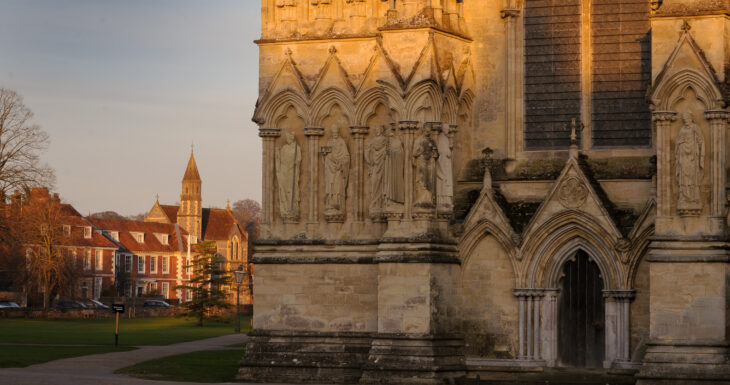Sarum College
19 The Close, Salisbury, Wiltshire, SP1 2EE

From the early Middle Ages, Salisbury was an important centre for theological training, its great cathedral and Close attracting students and scholars from the whole of Europe.
The history of theological study begins with St Osmund and the completion of the first cathedral at Old Sarum in 1092. After Old Sarum was abandoned in favour of New Sarum (or Salisbury, as it came to be known) and the new cathedral was built in the 1220s, several colleges were established as well as a medieval school of theology here on the site of 19 The Close.
The oldest part of Sarum College is the main building at the front of the site which was built in 1677. Attributed to Sir Christopher Wren, it was built for Francis Hill, a distinguished London lawyer and Deputy Recorder for Salisbury. He chose a particularly striking site, at the north end of Bishop’s Walk, facing directly down to the Bishop’s Palace, now the Cathedral School.
The establishment of the theological college in 1860 began with a gift. Walter Kerr Hamilton, Bishop of Salisbury, used an anonymous donation to buy the house (then no. 87) from Miss Charlotte Wyndham – and the first students arrived in January 1861.
In the 1870s William Butterfield, foremost church architect of his day, and best-known for Keble College, Oxford, was commissioned to add a residential wing to provide accommodation for students, and then, in 1881, a chapel and library. In 1937 further extensions designed by William Randall Blacking were added, study bedrooms for students and a meeting room that is now the Common Room.
Eight students of Salisbury Theological College were killed in WWl. A memorial in Butterfield Chapel records their names.
During WWll the College was taken over by the women of the Auxiliary Territorial Service, the women’s branch of the British Army.
In October 1971 the two theological colleges in Salisbury and Wells merged and became Salisbury & Wells Theological College. The additional students required more space, and two further extensions were built: a three storey block of flats and study bedrooms at the eastern end of the Butterfield building (the East Wing), and a new chapel (now the Royal School of Church Music’s administrative centre), refectory and library were added.
In 1994 Salisbury & Wells College closed, and the following year Sarum College was established to provide ecumenical theological education for all.
In 2006, the new link building joining the 1677 and 1877 buildings and incorporating lift access won the 2006 Salisbury Civic Society’s Conservation award. In early 2007 the five guest rooms in the Wren building were transformed from servants’ attic quarters to ensuite bedrooms with wonderful views across the Close to the cathedral.
In 2008, two of the four meeting rooms in the Wren building were refurbished.
The college dining room was refurbished in 2011, and in 2013 the Victorian wings with residential accommodation were renovated, bringing the total number of ensuite bedrooms to forty.
In 2015, the College library was given a comprehensive make-over thanks to a legacy from a keen library member, the late Heather Mathews.
The Common Room and Bar was refurbished in early 2016 through a grant from The Mercers’ Company.
Through a generous donation from the late Robert Seaton, the refurbishment of two new reception rooms on the ground floor of the 1677 building is scheduled to be completed in January 2023.
